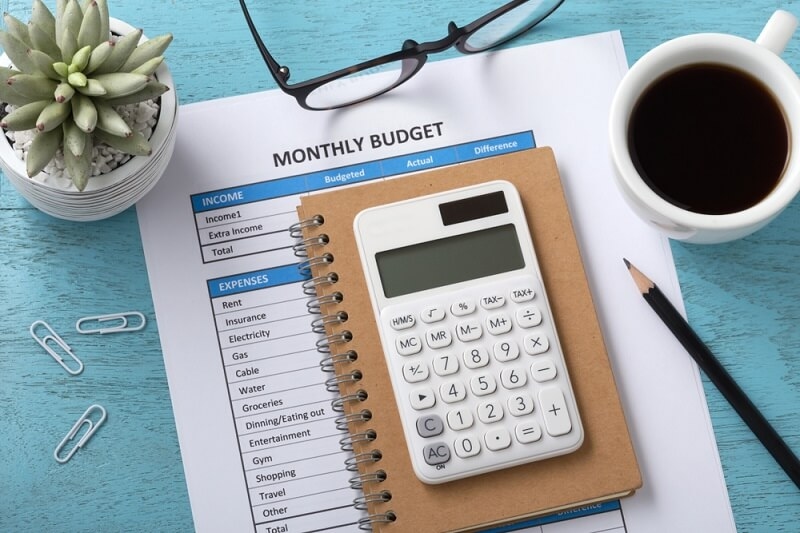
Budgeting is one of those things that most people know they should do, but starting to make a budget is a different story. That's where most people get stuck. The good news is you don't need to be a finance guru or math wizard to create a workable, no-stress, monthly budget. It only takes a few simple steps, such as your willingness to track your money and shifting your thinking from feeling stressed and anxious to feeling in control.
This guide will show you how to start budgeting monthly without neck pain or headaches. It provides simple budgeting steps for households in the U.S., whether you are an individual, a couple, or managing a monthly budget plan for families.
Let's take the fear out of budgeting once and for all.
Before setting up a first-time budget, it's helpful to know why budgeting feels so overwhelming:
Let me say again, budgeting is a plan. It is a tool you use to tell your money what to do-- so it doesn't do something else alone.
Before you start setting up your budget, change your mindset. Budgeting isn’t about depriving yourself of all fun—it is about intentionally spending your money. Budgeting is the basis for realizing your financial goals, whether paying off debt, saving for vacation, or home ownership.
Instead of thinking, “I can’t spend money,” believe, “I choose where my money is spent.”
Budgeting is a form of freedom, not a punishment.
To create a realistic budget, begin with what is coming in. If you are a salaried employee, this should be straightforward. If you are a freelancer, hourly employee, or otherwise have an ever-changing amount of income, calculate a monthly average for each income source over the last 3 to 6 months.
Avoid overestimating or inflating the realistic income, as you will ultimately be 'spending' the amount in your budget. If your average is higher than the actual income that brings your relative comfort, create your budget on your minimum average income.

If you don't know where you are, how will you know where you can go? Before setting budgets, do a check on what you are currently spending, and then you can create a budget defined by your own expenditures.
Just ensure that whatever you are using, you track at least 30 days of expenses to track what you are spending your money on. You can break it down into categories, like
So many people are shocked at how much they spend on food delivery services and streaming services. Tracking and defining your spending is the most important of all budgeting tips for beginners.
There’s no one-size-fits-all approach, and that’s a good thing. Choosing a method that aligns with your personality makes it easier to stick with. Here are three beginner-friendly options:
Great for first-timers who want a general framework without micromanaging every dollar.
Every dollar you earn is assigned a job—paying a bill, saving, or spending. Income – Expenses = $0.
Perfect for those who want total control over their finances.
Divide money into categories and spend only what’s available in each. You can use real envelopes or virtual tools.
This method helps control overspending and is ideal for people who struggle with swiping cards too often.
Now comes the fun part—actually putting together your first-time budget setup.
A well-balanced monthly budget plan for families also includes expenses related to children, like school fees, clothing, and extracurriculars.
One of the easy budgeting steps for U.S. households is to automate key transactions so you never forget them.
Automation reduces decision fatigue and helps you stick to your plan effortlessly.
A budget isn’t static—it should evolve with your needs. Set a monthly “budget review date” to evaluate what’s working and needs tweaking.
Ask yourself:
This reflection turns a basic budget into a powerful money management tool.
If you're managing money as a couple or family, could you include everyone? A monthly family budget plan works best when everyone understands and feels heard.
When everyone is on the same page, budgeting becomes a team effort, not a solo struggle.
Budgeting is not about being perfect—it’s about being proactive. You will mess up sometimes. You will overspend occasionally. That doesn’t mean you failed.
Give yourself room to learn and adjust. Progress beats perfection every time.
Here are some tools that make budgeting less intimidating for beginners:
These tools help streamline your first-time budget setup without adding complexity.
Avoid these rookie errors that can sabotage your budget:
Learning how to begin a monthly budget with a feeling of overwhelm comes down to simplifying the process and letting go of the obsession to be perfect. You don’t need a finance degree. You don’t need to stop drinking your favorite coffee. You need a plan.
If you can take small steps and find a budgeting style that suits your personality, and you hope, incorporate your family, track it, and allow flexibility through life changes, you will be on your way to budgeting fulfillment! Budgeting has nothing to do with saving money—it has to do with creating the life you want to live, one month at a time.
This content was created by AI